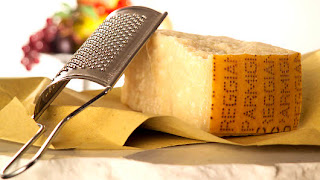
Arguably the greatest dairy product produced on the face of the earth, practically unchanged for over 700 years.
Parmigiano Reggiano has been documented to have been in existence as early as the 13th century. This is no laughing matter. There is nothing remotely laughable about this cheese. I use the term "cheese" for lack of a better word. It is quite possibly the greatest dairy product produced on the face of the earth and it has been practically unchanged for over 800 years.
Have you ever tried it? Have you ever experienced its delicacy or its nutty and slightly salient complexity? Were you aware that the swine raised to become prosciutto di Parma humbly nosh on the residual whey from the course of production of Parmigiano-Reggiano? And, did you know the consumption of this whey enhance the hams’s own flavor? Is it a coincidence that two of the most outstanding ingredients in gastronomy are interdependent on the same process? Probably not. And, is it fate that both these culinary operas derive from the same place on earth? Well, I am not completely confident fate exists, but it is fortuitous.
Still, there is a loop-hole. Look in your refrigerator. You might have an impostor, worthy of mocking. It is called parmesan (notice I did not capitalize it). Parmesan, I learned is a borrowed word from French that means Parmigiano. Parmigiano in Italian indicates something from Parma. In America, parmesan has become the generic term for cheeses that mimic the flavor of Parmigiano-Reggiano. These imitations are garbage. Sorry Kraft, nice try! We can make fun of them all we want. In the future, I might go on a blogging tirade about parmesan cheese, but we have more important issues at hand, and it's PARMAGEDDON. That's right, the end of the world record as we know it. This Saturday at 3:00pm EST Whole Foods Markets around the United States, Canada and the UK will attempt to simultaneously "crack" 500 wheels of authentic 2-year aged Pamigiano Reggiano. What will you be doing his Saturday afternoon? Shouldn't you be witnessing this historic event while scarfing down copious amounts of free Parmigiano Reggiano?
And I’m not trying to single out Kraft – I love their processed American Singles on burgers (as I recall this used to be called “American cheese food” because it couldn’t actually be labeled as “cheese,” but today they seem to dispense with the word cheese altogether). In fact, in terms of consumer confusion Kraft probably plays a very small role, since its ubiquitous dry powdered “cheese” in green cardboard tubes is so far removed from actual Parmigiano-Reggiano that virtually no one could confuse the two. In fact, an exhibit on imitation cheeses from other countries fills an entire room at the Parmigiano-Reggiano museum just outside of Parma, Italy. That's right, I said museum- a museum dedicated to a single recipe for cheese. The much bigger problem are the wedges of faux Parmigiano-Reggiano cheeses sold even at higher end supermarkets, gourmet stores, cheese specific shops and the high-priced national retailers purporting sell purer, better-for-you foods. Many of these imitators are produced here in the U.S. or South America, especially Argentina, and come with names such as Parmesan, Parmigiana, Parmesana, Parmabon, Real Parma, Parmezan, Parmezano and my all-time favorite, Permesansan (really). But most of the faux Parmigiano-Reggiano you will find here in the States is called simply Parmesan, and anyone who doubts for a second that its manufacturers are trading on the good name of the real stuff only has to consider that the 800 year old Parmigiano-Reggiano is named for its birthplace, Parma, an actual city.


No comments:
Post a Comment